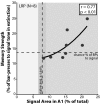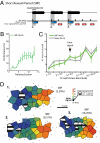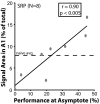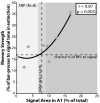Representational gain in cortical area underlies increase of memory strength
- PMID: 20133679
- PMCID: PMC2840533
- DOI: 10.1073/pnas.1000159107
Representational gain in cortical area underlies increase of memory strength
Erratum in
- Proc Natl Acad Sci U S A. 2013 Mar 26;110(13):5269
Abstract
Neuronal plasticity that develops in the cortex during learning is assumed to represent memory content, but the functions of such plasticity are actually unknown. The shift in spectral tuning in primary auditory cortex (A1) to the frequency of a tone signal is a compelling candidate for a substrate of memory because it has all of the cardinal attributes of associative memory: associativity, specificity, rapid induction, consolidation, and long-term retention. Tuning shifts increase the representational area of the signal in A1, as an increasing function of performance level, suggesting that area encodes the magnitude of acquired stimulus significance. The present study addresses the question of the specific function of learning-induced associative representational plasticity. We tested the hypothesis that specific increases in A1 representational area for an auditory signal serve the mnemonic function of enhancing memory strength for that signal. Rats were trained to bar-press for reward contingent on the presence of a signal tone (5.0 kHz), and assessed for memory strength during extinction. The amount of representational area gain for the signal frequency band was significantly positively correlated with resistance to extinction to the signal frequency in two studies that spanned the range of task difficulty. These findings indicate that specific gain in cortical representational area underlies the strength of the behaviorally-relevant contents of memory. Thus, mnemonic functions of cortical plasticity are determinable.
Conflict of interest statement
The authors declare no conflict of interest.
Figures





References
-
- Bakin JS, Weinberger NM. Classical conditioning induces CS-specific receptive field plasticity in the auditory cortex of the guinea pig. Brain Res. 1990;536:271–286. - PubMed
-
- Bakin JS, South DA, Weinberger NM. Induction of receptive field plasticity in the auditory cortex of the guinea pig during instrumental avoidance conditioning. Behav Neurosci. 1996;110:905–913. - PubMed
-
- Diamond DM, Weinberger NM. Classical conditioning rapidly induces specific changes in frequency receptive fields of single neurons in secondary and ventral ectosylvian auditory cortical fields. Brain Res. 1986;372:357–360. - PubMed
-
- Edeline J-M, Pham P, Weinberger NM. Rapid development of learning-induced receptive field plasticity in the auditory cortex. Behav Neurosci. 1993;107:539–551. - PubMed
Publication types
MeSH terms
Grants and funding
LinkOut - more resources
Full Text Sources
Medical

